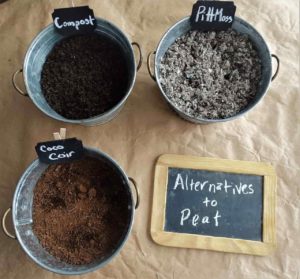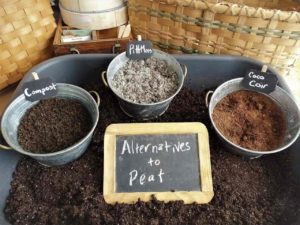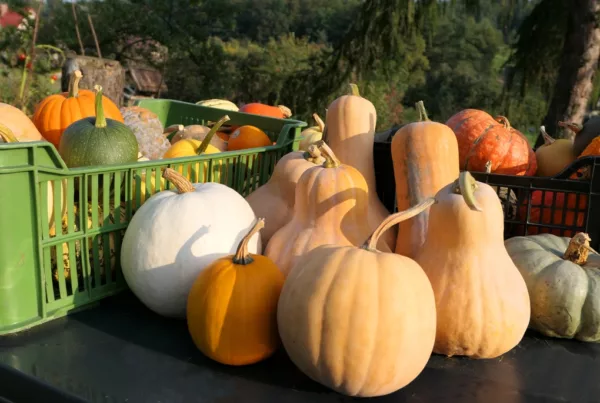Written by Alex Darc
Sadly, peat is a slow growing, natural resource that hasn’t always been well managed, and in many places has been seriously depleted, leaving negative effects on the environment. Many gardeners are looking for a peat alternative.
 Mel’s Mix is a carefully chosen, balanced growing medium consisting of 1/3 peat, 1/3 vermiculite and 1/3 blended compost. It is ph neutral, nutrient rich, friable, and well draining without drying out. All three ingredients play their part in creating this winning combination.
Mel’s Mix is a carefully chosen, balanced growing medium consisting of 1/3 peat, 1/3 vermiculite and 1/3 blended compost. It is ph neutral, nutrient rich, friable, and well draining without drying out. All three ingredients play their part in creating this winning combination.
I made several batches of Mel’s Mix with three alternatives to peat, Coconut Coir, Pitt Moss, and Aged Blended Compost and here is what I found out.
Coconut Coir: Coir is a byproduct of the coconut farming industry and as such it is considered more sustainable than peat. Depending on where you live, it may have a considerable carbon foot print as most coir is manufactured in India and Sri Lanka. It is also often farmed in places that had been rainforests until they were razed to farm coconuts. So, compared to responsibly harvested peat, it may not be a clear choice..
Coir has a natural ph range of 6 to 6.8, whereas peat has a ph range of 3.5 -4.8. Because of this high ph range, it is important to know the ph of your water. You may need to periodically check the ph of your beds to keep them from becoming alkaline.
Coir is much easier to wet and re-wet than peat. Peat moss actually can repel water if it is not adequately saturated before being added to your mix. Peat can hold 10 to 20 times its dry weight in water, but coir only holds about 8-9 times its dry weight. Given this, coir based mixes may need to be watered more often than peat. The Mel’s Mix I made with coir felt light and fluffy, and seemed to retain the same amount of moisture over a period of 5 days as the Mel’s Mix I made with Peat.
Pitt Moss: Pitt Moss Prime is an organic, OMRI approved peat moss alternative made in the USA, from recycled paper. It is a very sustainable choice. I like that the company offers free shipping.
It has a natural ph in the range of 6-7, and as such will require the same attention to ph in the beds as coir.
The Mel’s Mix I made with Pitt Moss had the closest consistency to peat in the final mix. It absorbs water much more readily than peat, or coir, and in my tests stayed wetter for longer. I was surprised how much I liked working with the product. It was lighter than peat (to carry and mix), didn’t take as much water to wet it and it seemed to blend into the other ingredients easily. The manufacturer suggests allowing the mix you blend to compost for at least 10 days before planting in it.
Aged Blended Compost: This final option is the perhaps the most sustainable. Compost, preferably made from a variety of sources is extremely sustainable, and if you make your own, has virtually no carbon footprint. Properly aged compost should have a ph of 6-8. Compost ph varies during its lifecycle though, and as it decays, the ph changes. This doesn’t matter quite as much when using peat (which lowers the ph) in your Mel’s Mix but can matter if your compost makes up 2/3 of the mix. You want to use it when it is closer to a ph of 6 than 8. Alkaline soils can prevent the absorption of micronutrients in the soil.
 The Mel’s Mix I made with homemade compost had a great consistency and feel but did dry out far faster than the Pitt Moss or the Coir. If I did this again, I might consider adding more vermiculite to help hold on to that moisture.
The Mel’s Mix I made with homemade compost had a great consistency and feel but did dry out far faster than the Pitt Moss or the Coir. If I did this again, I might consider adding more vermiculite to help hold on to that moisture.
After all my experimenting, I would feel confident using any of these alternatives in my bed, with two caveats
1. Watch your ph, and don’t let it go out of neutral range
2. Watch your moisture levels (some of these will dry out faster than Mel’s Mix made with peat, some may get waterlogged with huge amounts of rain, etc.).
Mel chose the three components of Mel’s Mix carefully to balance each other in drainage, moisture retention and ph to make growing easy. If you are looking to replace peat in the mix, you may have to be a little more hands-on, test your soil for ph regularly, and you may have to adjust your usual watering routine, but it is absolutely possible to SFG peat free.



